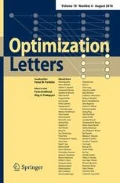Abstract
This paper proposes a representation of the family of Minkowski distances using fuzzy sets. The proposed method helps to represent human-like perceptions about distances, which can help decision making in presence of non-probabilistic uncertainties such as imprecision and ambiguity. This way we propose to define a fuzzy set regarding the concept of closeness of two elements/sets measured by a Minkowski metric. Two application examples are presented, solved, and compared to some classical approaches. Finally some concluding remarks are provided and some interpretation issues are explained.









Similar content being viewed by others
References
Barnett, V., Lewis, T.: Outliers in Statistical Data. Wiley, New York (1978)
Bede, B.: Mathematics of Fuzzy Sets and Fuzzy Logic. Springer, New York (2013)
Chaudhuri, B.B., Rosenfeld, A.: A modified Hausdorff distance between fuzzy sets. Inf. Sci. 118, 159–171 (1999)
Diamond, P., Kloeden, P.: Fundamentals of Fuzzy Sets, vol. 7, Chapter Metric Topology of Fuzzy Numbers and Fuzzy Analysis. Springer, New York (2000)
Figueroa-García, J.C., Chalco-Cano, Y., Román-Flores, H.: Distance measures for interval type-2 fuzzy numbers. Discrete Appl. Math. 197(1), 93–102 (2015)
Figueroa-García, J.C., Hernández-Pérez, G.J.: On the computation of the distance between interval type-2 fuzzy numbers using a-cuts. In: IEEE, editor, Annual Meeting of the North American Fuzzy Information Processing Society (NAFIPS), vol. 1, pp. 1–6. IEEE (2014)
Figueroa-García, J.C., López-Santana, E., Franco-Franco, C.: A distance measure between fuzzy variables. Commun. Comput. Inf. Sci. 742(1), 1–6 (2017)
Hamming, R.: Numerical Methods for Scientists and Engineers. Dover Publishings, New York (1987)
Hodge, V.J., Austin, J.: A survey of outlier detection methodologies. Artif. Intell. Rev. 22(2), 85–126 (2004)
Huber, P.: Robust Statistics. Wiley, New York (1981)
Jaulin, L.: Probabilistic set-membership approach for robust regression. J. Stat. Theory Pract. 4(1), 155–167 (2010)
Knorr, E.M., Ng, R.T., Tucakov, V.: Distance-based outliers: algorithms and applications. VLDB J. 8(3–4), 237–253 (2000)
Minkowski, H.: Die grundgleichungen für die elektromagnetischen vorgänge in bewegten körpern. Math. Ann. 68(4), 472–525 (1910)
Varón-Gaviria, C.A., Barbosa-Fontecha, J.L., Figueroa-García, J.C.: Fuzzy uncertainty in random variable generation: an \(\alpha \)-cut approach. Lect. Notes Artif. Intell. 10363(1), 1–10 (2017)
Xuechang, L.: Entropy, distance measure and similarity measure of fuzzy sets and their relations. Fuzzy Sets Syst. 52, 305–318 (1992)
Author information
Authors and Affiliations
Corresponding author
Rights and permissions
About this article
Cite this article
Figueroa-García, J.C., Melgarejo-Rey, M.A. & Hernández-Pérez, G. Representation of the Minkowski metric as a fuzzy set. Optim Lett 14, 395–408 (2020). https://doi.org/10.1007/s11590-018-1290-6
Received:
Accepted:
Published:
Issue Date:
DOI: https://doi.org/10.1007/s11590-018-1290-6




